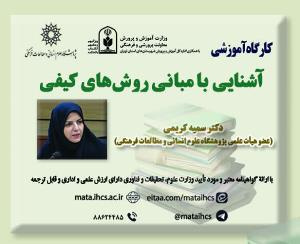گویش شناسی اسامی خاص: رویکردی نوین در مطالعات گویش شناسی و نام شناسی: (مطالعه موردی: گویش سورانی، گونه های سردشتی و بانه ای) (مقاله علمی وزارت علوم)
درجه علمی: نشریه علمی (وزارت علوم)
آرشیو
چکیده
«شاخه میان رشته ای» گویش شناسی اسامی خاص براساس رویکرد تنوع گرا و این باور پایه گذاری شد که نام ها صرفاً کارکردی ارجاعی ندارند، بلکه حاوی اطلاعاتی در مورد تنوعات جغرافیایی و اجتماعی و نیز هویت فرد هستند. معرفی این رویکرد علمی، هدف پژوهش حاضر است. روش انجام پژوهش توصیفی-تحلیلی است و داده های تحقیق به صورت میدانی و با کمک افراد مطلع ساکن در روستاهای مختلف شهرستان های بانه و سردشت، دهیارها و معلمان این روستاها و نیز در مواردی با استفاده از اطلاعات و شم زبانی نگارنده گردآوری شده اند. نتایج تحقیق حاضر نشان داد که که بین دو گونه سورانی (سردشتی و بانهای) به لحاظ تلفظ برخی از نام های افراد تفاوت وجود دارد. در بررسی نوع نام گذاری ، مشخص شد نام گذاری استعاره بنیاد با تکیه بر مفاهیم برگرفته از طبیعت در کردی سورانی جایگاه و نقش خاصی دارد. در بخش لقب گذاری برای افراد، با بررسی القاب به کار رفته در گونه بانه ای مشخص شد ویژگی های ظاهری و رفتاری فرد مبنای لقب گذاری می است. در بخش نام گذاری حیوانات نیز مشخص شد گویشوران سورانی حیوانات اهلی را بر مبنایی استعاری، مشخصات ظاهری و رفتاری نام گذاری می کنند. نام گذاری اماکن طبیعی در کردی سورانی بر اساس استعاره، مجاز، مشخصات ظاهری و ... و در مورد سکونت گاه ها بر اساس نام فردی شاخص، همجواری با چشمه ها و رودها و... است. بررسی تنوع و گوناگونی زبانی در اسامی خاص در حوزه گویش سورانی نشان داد اسامی خاص می توانند از جنبه های مختلف از جمله گوناگونی جغرافیایی نام گذاری ، تنوع جغرافیایی در تلفظ نام یکسان، نام گذاری استعاره بنیاد، لقب گذاری برای افراد، نام گذاری حیوانات و نام گذاری اماکن، شاخص مناسب و موضوع شایان توجهی در گویش شناسی باشند.Dialectology of Proper Names: A New Approach in Dialectology and Onomastics (Case Study: Sorani Dialect, Sardasht and Baneh Varieties)
Background and Aim: From a variationist perspective and with the idea that names do not merely have a referential function, but also contain information about geographical and social variations, the present study aimed to introduce the interdisciplinary discipline of “Dialectology of Proper Names”.
Method: The research method used in this research was descriptive-analytical and the data were collected in the field with the help of informed people living in different villages of Baneh and Sardasht villagers, teachers in these villages, and also in some cases using the researcher’s information intuition.
Results: The results of the present research showed a difference between the Sardashti and Baneh varieties in terms of the pronunciation of some proper names, which is in line with the differences between these two varieties of Sorani dialect. In examining the type of naming, it was found that metaphor-based naming, relying on concepts derived from nature, has a special place and role in Sorani Kurdish. Regarding nicknaming of people, examining the nicknames used in Baneh variety indicated that a person's appearance and behavioral characteristics could be the basis for nicknames. The animal naming section showed that Sorani speakers name domestic animals based on metaphors, their appearance, and behavioral characteristics. The naming of natural places in Surani Kurdish was based on metaphor, metonymy, appearance characteristics, etc., and in the case of settlements, it was based on the name of a prominent person, proximity to springs and rivers, etc.
Conclusion: Investigating the linguistic variation and diversity of proper nouns in the Surani dialect showed that proper nouns can be used as suitable variation indicators in dialectology, from different perspectives: geographic variation in proper names, geographic variation in the pronunciation of the same name, metaphor-based naming, nicknaming of people, naming animals, and place names
.







